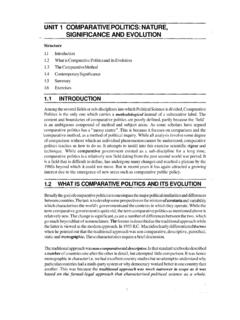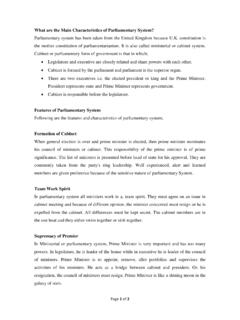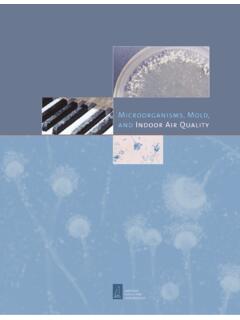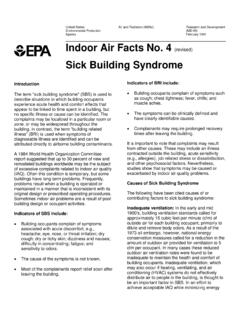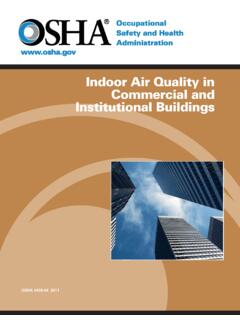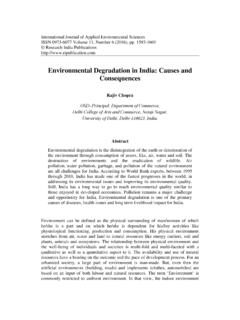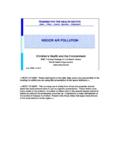Transcription of ENVIRONMENTAL POLLUTION - Shivaji College
1 ENVIRONMENTAL Science Senior Secondary CourseNotes164 MODULE - 4 ContemporaryEnvironmental Issues10 ENVIRONMENTAL POLLUTIOND evelopmental activities such as construction, transportation and manufacturing not onlydeplete the natural resources but also produce large amount of wastes that leads to pollutionof air, water, soil, and oceans; global warming and acid rains. Untreated or improperlytreated waste is a major cause of POLLUTION of rivers and ENVIRONMENTAL degradation causingill health and loss of crop productivity. In this lesson you will study about the major causesof POLLUTION , their effects on our environment and the various measures that can be taken tocontrol such pollutions. OBJECTIVESA fter completing this lesson, you will be able to: define the terms POLLUTION and pollutants; list various kinds of POLLUTION ; describe types of POLLUTION , sources, harmful effects on human health and controlof air POLLUTION , indoor air POLLUTION , noise POLLUTION ; describe water POLLUTION , its causes and control; describe thermal POLLUTION ; describe soil POLLUTION , its causes and control; describe radiation POLLUTION , sources and hazards.
2 POLLUTION AND POLLUTANTSH uman activities directly or indirectly affect the environment adversely. A stone crusheradds a lot of suspended particulate matter and noise into the atmosphere. Automobilesemit from their tail pipes oxides of nitrogen, sulphur dioxide, carbon dioxide, carbonmonoxide and a complex mixture of unburnt hydrocarbons and black soot which pollutethe atmosphere. Domestic sewage and run off from agricultural fields, laden with pesticides165 ENVIRONMENTAL PollutionNotesMODULE - 4 ContemporaryEnvironmental Issuesand fertilizers, pollute water bodies. Effluents from tanneries contain many harmful chemicalsand emit foul smell. These are only a few examples which show how human activitiespollute the environment. POLLUTION may be defined as addition of undesirable material intothe environment as a result of human activities. The agents which cause environmentalpollution are called pollutants.
3 A pollutants may be defined as a physical, chemical orbiological substance unintentionally released into the environment which is directly orindirectly harmful to humans and other living organisms. TYPES OF POLLUTIONP ollution may be of the following types: Air POLLUTION Noise POLLUTION Water POLLUTION Soil POLLUTION Thermal POLLUTION Radiation POLLUTION AIR POLLUTIONAir POLLUTION is a result of industrial and certain domestic activity. An ever increasing use offossil fuels in power plants, industries, transportation, mining, construction of buildings,stone quarries had led to air POLLUTION . Air POLLUTION may be defined as the presence ofany solid, liquid or gaseous substance including noise and radioactive radiation in theatmosphere in such concentration that may be directly and indirectly injurious to humansor other living organisms, plants, property or interferes with the normal environmentalprocesses.
4 Air pollutants are of two types (1) suspended particulate matter, and (2) gaseouspollutants like carbon dioxide (CO2), NOx etc. Some of the major air pollutants, theirsources and effects are given in table : Particulate air pollutants, their sources and effectsPollutantSourcesEffectsSuspended particulateSmoke from domestic,Depends on specific compositionmatter/dustindustrial and vehicular sootReduces sunlight and visibility,increases corrosion, Pneumoconiosis,asthma, cancer, and other lung ashPart of smoke released fromSettles down on vegetation, houses. Addschimneys of factories andto the suspended participate matter (SPM)power plantsin the air. Leachates contain harmfulmaterialEnvironmental Science Senior Secondary CourseNotes166 MODULE - 4 ContemporaryEnvironmental Particulate pollutantsParticulate matter suspended in air are dust and soot released from the industrial size ranges from to 500 m in diameter.
5 Particles less than 10 m float andmove freely with the air current. Particles which are more than 10 m in diameter settledown. Particles less than m form persisent aerosols. Major source of SPM (suspendedparticulate matter) are vehicles, power plants, construction activities, oil refinery, railwayyard, market place, industries, etc. Fly ashFly ash is ejected mostly by thermal power plants as by products of coal burning ash pollutes air and water and may cause heavy metal POLLUTION in water bodies. Flyash affects vegetation as a result of its direct deposition on leaf surfaces or indirectlythrough its deposition on soil. Fly ash is now being used for making bricks and as a land fillmaterial. Lead and other metals particlesTetraethyl lead (TEL) is used as an anti-knock agent in petrol for smooth and easy runningof vehicles. The lead particles coming out from the exhaust pipes of vehicles is mixed withair.
6 If inhaled it produces injurious effects on kidney and liver and interferes with developmentof red blood cells. Lead mixed with water and food can create cumulative poisoning. Ithas long term effects on children as it lowers of iron, aluminum, manganese, magnesium, zinc and other metals have adverseeffect due to deposition of dust on plants during mining operations and metallurgicalprocesses. They create physiological, biochemical and developmental disorders in plantsand also contribute towards reproductive failure in : Annual average concentration of pollutants in ambient air inresidential and industrial areas (year 2000) mg/m3 in 24 hoursSPM permissible- residential 140 200 mg/m3, industrial 360 500 mg/m3 CityResidential areaIndustrial areaAgra349388 Bhopal185160 Delhi368372 Kanpur348444 Kolkata218405 Nagpur140157167 ENVIRONMENTAL PollutionNotesMODULE - 4 ContemporaryEnvironmental Gaseous pollutantsPower plants, industries, different types of vehicles both private and commercial usepetrol, diesel as fuel and release gaseous pollutants such as carbon dioxide, oxides ofnitrogen and sulphur dioxide along with particulate matter in the form of smoke.
7 All ofthese have harmful effects on plants and humans. Table lists some of these pollutants,their sources and harmful : Gaseous air pollutants: their sources and effectsPollutantSourceHarmful effectCarbon compoundAutomobile exhaust Respiratory problems(CO and CO2)burning of wood and coal Green house effectSulphur compoundsPower plants and refineries Respiratory problems in humans(SO2 and H2S)volcanic eruptions Loss of chlorophyll in plants (chlorosis) Acid rainNitrogen CompoundMotor vehicle exhaust Irritation in eyes and lungs(NO and N2O)atmospheric reaction Low productivity in plants Acid rain damages material (metals and stone)HydrocarbonsAutomobiles and Respiratory problem(benzene, ethylene)petroleum industries Cancer causing propertiesSPM (SuspendedThermal power plants, Poor visibility, breathing problemsParticulate Matter)Construction activities, Lead interfers with the development(Any soild and liquid)
8 Metalurgical processes of red blood diseases and suspendedand automobiles Smoge (skoke & fog) formation leadsin the air, (flush, dust, to poor visibility and aggravateslead) asthma in patientsFibres (Cotton, wool)Textiles and carpet weaving Lung disordersindustriesFig. : A chimney billowing smoke- Diesel vehicle ( bus/truck) showingexhaust smokeEnvironmental Science Senior Secondary CourseNotes168 MODULE - 4 ContemporaryEnvironmental and control of air POLLUTION (i) indoor air pollutionPoor ventilation due to faulty design of buildings leads to POLLUTION of the confined , carpets, furniture, etc. in rooms may give out volatile organic compounds (VOCs).Use of disinfectants, fumigants, etc. may release hazardous gases. In hospitals, pathogenspresent in waste remain in the air in the form of spores. This can result in hospital acquiredinfections and is an occupational health hazard.
9 In congested areas, slums and rural areasburning of firewood and biomass results in lot of smoke. Children and ladies exposed tosmoke may suffer from acute respiratory problems which include running nose, cough,sore throat, lung infection, asthama, difficulty in breathing, noisy respiration and wheezing.(ii) Prevention and control of indoor air pollutionUse of wood and dung cakes should be replaced by cleaner fuels such as biogas, keroseneor electricity. But supply of electricity is limited. Similarly kerosene is also limited. Improvedstoves for looking like smokeless chullahs have high thermal efficiency and reduced emissionof pollutants including smoke. The house designs should incorporate a well ventilatedkitchen. Use of biogas and CNG (Compressed Natural Gas) need to be species of trees such as baval (Acacia nilotica) which are least smoky should beplanted and used. Charcoal is a comparatively cleaner fuel.
10 indoor POLLUTION due to decayof exposed kitchen waste can be reduced by covering the waste properly. Segregation ofwaste, pretreatment at source, sterilization of rooms will help in checking indoor air POLLUTION .(iii) Prevention and control of industrial pollutionIndustrial POLLUTION can be greatly reduced by:(a)use of cleaner fuels such as liquefied natural gas (LNG) in power plants, fertilizerplants etc. which is cheaper in addition to being environmentally friendly.(b)employing environment friendly industrial processes so that emission of pollutants andhazardous waste is minimized.(c)installing devices which reduce release of pollutants. Devices like filters, electrostaticprecipitators, inertial collectors, scrubbers, gravel bed filters or dry scrubbers aredescribed below:(i)Filters Filters remove particulate matter from the gas stream. The medium of a filtermay be made of fibrous materials like cloth, granular material like sand, a rigid materiallike screen, or any mat like felt pad.



